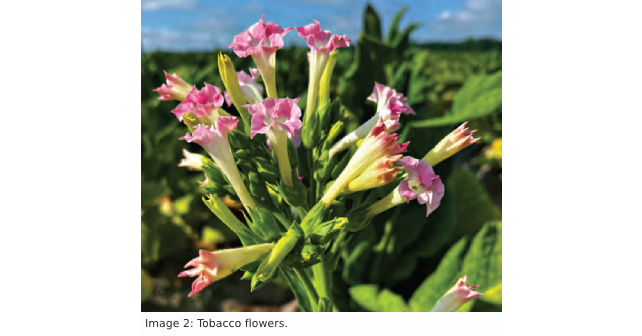
The Plant
N. tabacum is an herbaceous annual that has a thick, hairy stem and grows to about two to four feet in height. During its lifecycle, it produces clustered flowers (inflorescence) at its apex, which are tubular and have a corolla with five petals colored white, yellow, pink, or red. [image 2—tobacco flowers]. These flower bundles are physically removed from the plant (called “topping”) during a specific period of the growing season to stimulate the remaining green leaves to become bigger and promote root growth. (Nicotine is formed in the roots and sent to the leaves.) The leaves, the economically important part of the tobacco plant, grow alternately up the stem, are elliptical with a point, and grow to be 20 inches long and 10 inches wide. Dew on the leaves can contain up to nine percent nicotine.
Explore This Issue
ACEP Now: Vol 43 – No 10 – October 2024Toxins
The plant’s major toxic alkaloid is nicotine, which binds to nicotinic acetylcholine receptors (nAChRs), is considered a psychostimulant, can produce analgesia and anxiolytic effects, and stimulates specific reward pathways in the brain at low doses. In larger doses, its effects include directly agonizing the medullary emetic chemoreceptor trigger zone, causing vomiting. Nicotine also stimulates sensory and parasympathetic nerves from the gastrointestinal (GI) tract, increasing fluid secretion and peristalsis and interacting with the nicotinic receptors in the central nervous system (CNS) and post-synaptic autonomic ganglia, causing CV fluctuations, weakness, and CNS excitement.
Tobacco also contains thousands of metabolites, which are being explored for both chemical and biologic uses—isoprenoids, flavonoids, cembranoid compounds volatiles, and recently acyclic hydroxygeranyllinalool diterpene glycosides have been characterized.4,11,14
Toxicity*: (*There is not enough room in this column to discuss the oncologic, pulmonary, hematologic, and other effects of tobacco or nicotine on humans. We will focus on one toxicity directly from the plant.)
Green Tobacco Sickness
Nicotine poisoning may occur from occupational exposures in workers who come in direct contact with the plant or its liquids, even through intact skin during crop maintenance—activities such as topping (cutting the flowers off), sucker removal (taking off the smaller side leaves), harvesting the leaves for processing, and working in the drying (curing) areas.
Several factors contribute to nicotine exposure and poisoning during this work—(1) Leaf harvesting usually occurs in late August or September when there is elevated ambient temperature and humidity, and frequent rain; (2) this causes sweating; (3) the heat discourages wearing protective clothing; and (4) physical labor increases dermal vascular dilation, which increases nicotine absorption by 45 percent; (5) water or dew on the tobacco leaves absorbs nicotine from the plant and can contain up to nine mg of nicotine per 100 mL; the average worker is exposed to approximately 600 mL of nicotine-containing dew per day (54 mg = 36 cigarettes) [cigarettes contain about 10 mg nicotine; 1.1-1.8 mg are absorbed through smoking]).2,8 Younger workers are especially vulnerable to green tobacco sickness because of their size and lack of tolerance and experience.2
Pages: 1 2 3 4 | Single Page





No Responses to “Toxicology Answer: The Pretty and Toxic Tobacco”